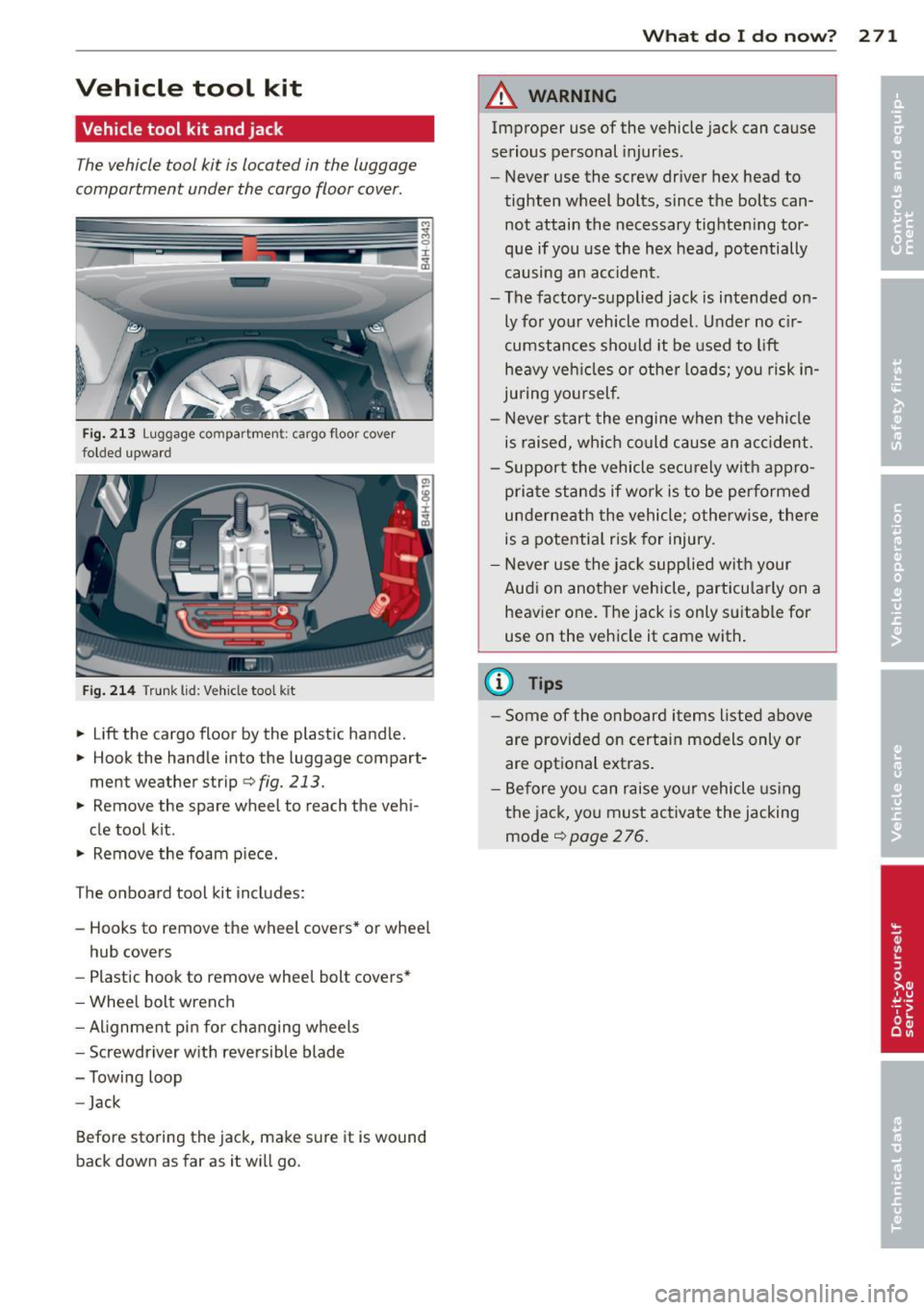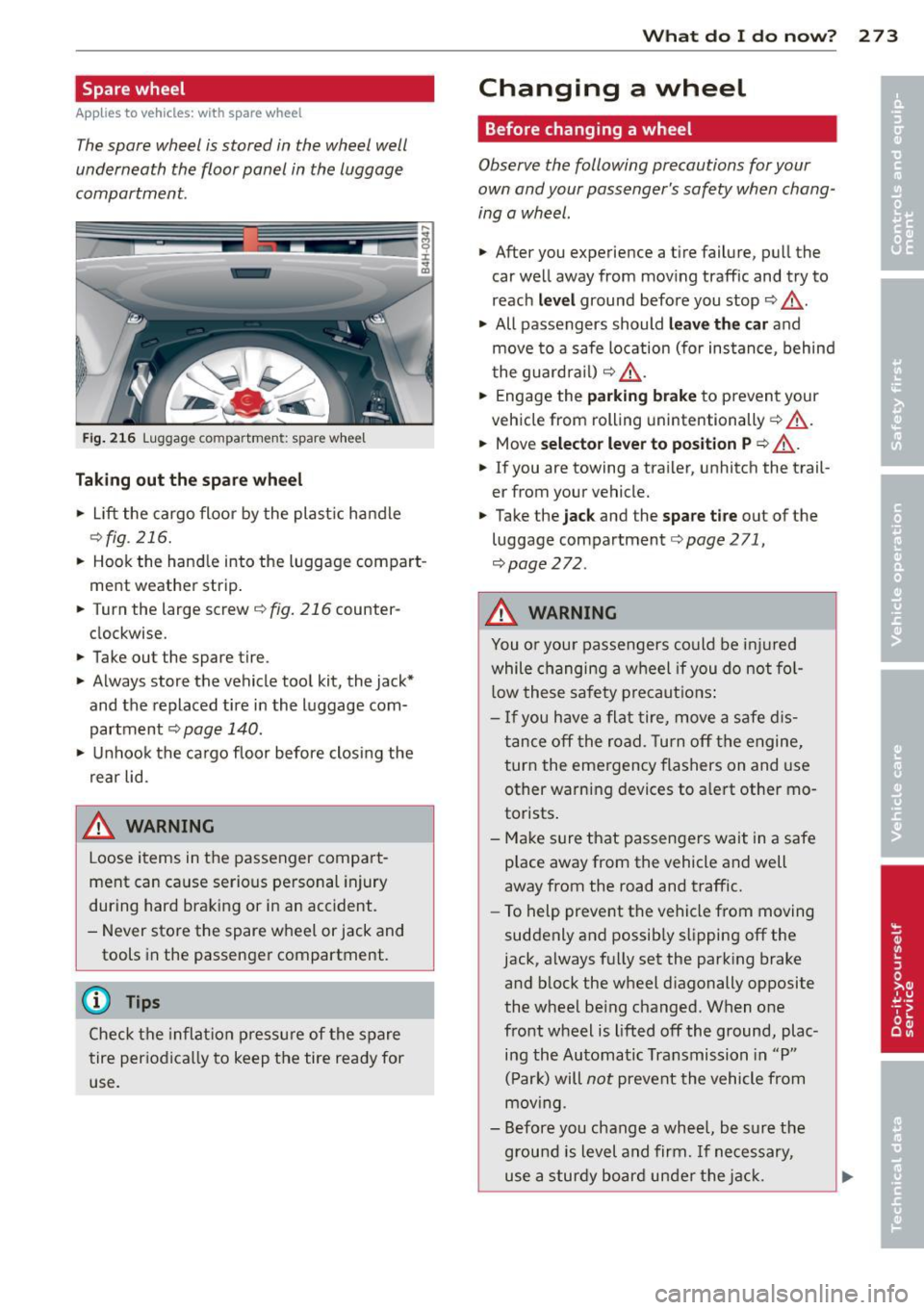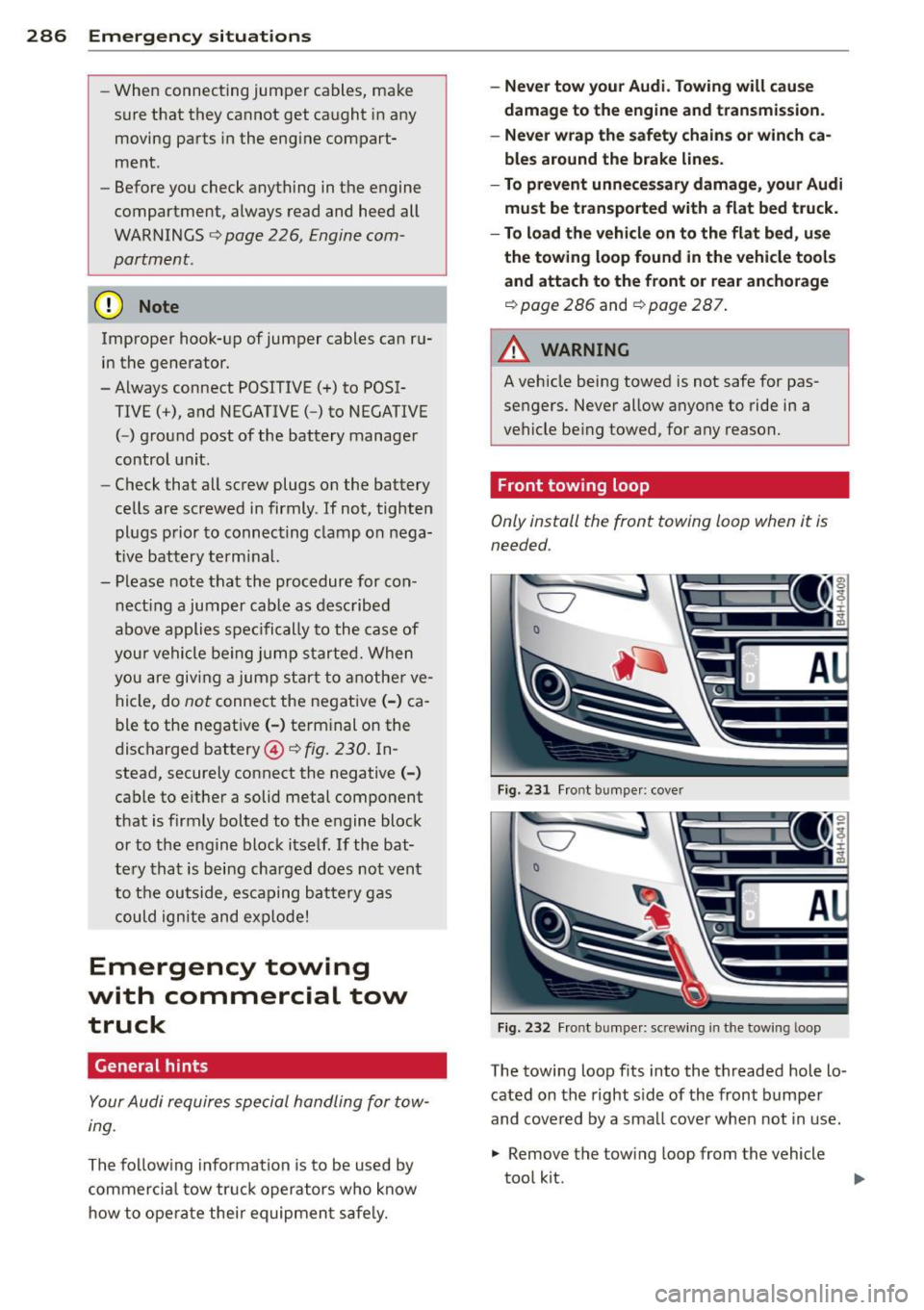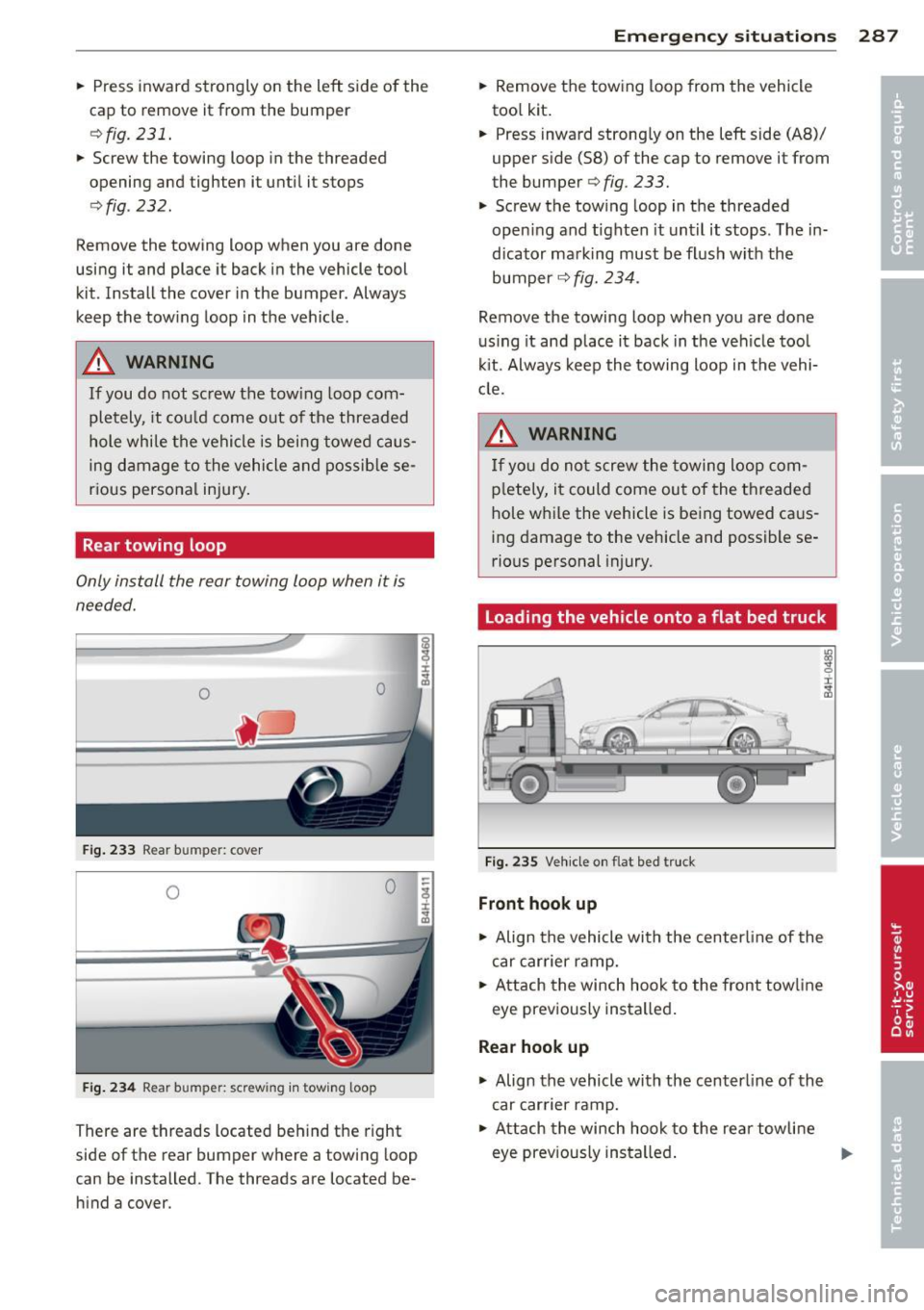towing AUDI A8 2013 Owner's Manual
[x] Cancel search | Manufacturer: AUDI, Model Year: 2013, Model line: A8, Model: AUDI A8 2013Pages: 318, PDF Size: 79.34 MB
Page 216 of 318

214 Trailer towing
• Start the engine.
• Se lect the D selector lever position.
• Re lease the park ing brake and slowly pull
out and away from the wheel chocks.
• Stop and have someone retrieve the wheel
chocks.
(D Tips
If you move the selector lever of the auto mat ic transm ission to P before app lying
the park ing brake and before blocking the
wheels, you may have to use more force later to move the lever out of the P posi
tion.
Page 273 of 318

Vehicle tool kit
Vehicle tool kit and jack
The vehicle tool kit is located in the luggage
compartment under the cargo floor cover.
Fi g. 213 Luggage compartme nt: cargo floor cover
folded upward
Fig. 214 Trunk lid: Vehicle too l kit
.. Lift the cargo floor by the plastic handle.
.. Hook the handle into the luggage compart
ment weather strip¢
fig. 213.
.. Remove the spare wheel to reach the veh i-
cle tool kit .
.. Remove the foam p iece.
The onboard tool kit includes:
- Hooks to remove the wheel covers* or whee l
hub covers
- Plastic hook to remove wheel bolt covers*
- Wheel bolt wrench
- Al ignment p in for changing wheels
- Screwdriver with reversible blade
- Towing loop
- Jack
Before storing the jack, make sure it is wound
back down as far as it will go.
What do I d o now ? 271
A WARNING
Im proper use of the vehicle jack can cause
serious personal injur ies.
- Never use the screw driver hex head to
tighten wheel bolts, since the bolts can
not attain the necessary tighten ing tor
que if you use the hex head, potentially
causing an accident.
- The factory-supplied jack is intended on
ly for yo ur vehicle model. Under no c ir
cumstances sho uld it be used to lift
heavy veh icles or other loads; you risk in
ju ring yo urself.
- Never start the engine when the vehicle
is raised, wh ich could cause an acc ident.
- Support the vehicle securely with appro
priate stands if work is to be performed
underneath the vehicle; otherwise, there
is a potentia l risk for injury.
- Never use the jack supplied wit h your
Audi on another vehicle, particularly on a
heavier one. The jack is only s uitable for
use on the vehicle it came with.
(D Tips
- Some of the onboard items listed above
are provided on certain models only or
are optional ext ras .
- Before yo u can raise your vehicle using
the jack, you must activate the jacking
mode ¢
page 2 76 .
Page 275 of 318

Spare wheel
Applies to vehicles: with spare wheel
The spare wheel is stored in the wheel well
underneath the floor panel in the luggage
compartment.
F ig. 21 6 Luggag e compartme nt: spare wheel
Taking out the sp are whee l
• Lift the cargo floor by the plast ic handle
c:> fig . 216.
• Hook the hand le into the luggage compart
ment weather strip .
• Turn the large screw
c:> fig. 216 counter
clockwise.
• Take out the spare tire.
• Always store the vehicle tool kit, the jack*
and the replaced tire i n the luggage com
partment
c:> page 140 .
• Unhook the ca rgo floor before closing the
rear lid.
& WARNING
Loose items in the passenger compa rt
ment can cause serious pe rsonal in jury
during hard braking or in an accident.
- Never store the spare wheel or jack and
tools in the passenger compartment.
@ Tips
Check the inflat io n press ure of the spare
tire periodically to keep the tire ready for
use.
-
What do I d o now ? 273
Changing a wheel
Before changing a wheel
Observe the following precautions for your
own and your passenger's safety when chang
ing a wheel.
• After you experience a tire failure, pull the
car well away from mov ing traffic and try to
reach
le vel ground before you stop c:> ,&.
• All passengers should leave the car and
move to a safe location (for ins tance, behind
t he guardra il)
c:> ,& .
• Engage the parking brak e to prevent your
vehicle from rolling unintentionally
c:> ,& .
• Move sele ctor lever to po sit ion Pc:> &_ .
• If you are towing a trailer, unhitch the trail
er from your vehicle.
• Take the
jack and the spare tire out of the
luggage compartment
c:> page 271,
c:> page
272 .
& WARNING
You o r you r passengers could be i njured
while changing a wheel if you do not fo l
low these safe ty pre caut ions :
-I f you have a flat tire, move a safe d is
tance off the road. Turn off the e ngine,
turn the emergency flashers on and use
other warning devices to a lert other mo
torists .
- Make sure that passengers wait in a safe
place away from the vehicle and well
away from the road and traffic.
- To help prevent the vehicle from moving
suddenly and possib ly slipping off the
jack, always full y set the parking brake
a nd b lock the wheel d iagonally opposite
the wheel be ing changed. When one
front wheel is lifted off the ground, plac ing the Au tomatic Transmission in "P"
( P ar k) will
not prevent the vehicle from
mov ing .
- Before you chang e a whee l, be s ure the
g round is level and firm. If necessary,
use a sturdy board un der the jac k.
-
Page 286 of 318

284 Emergency situations
Emergency situations
General
This chapter is intended for trained emer
gency crews and working personnel who
have the necessary tools and equipment to
perform these ope rations.
Starting by pushing or
towing
Q;) Note
Vehicles w ith an automatic transmission
cannot be started by pus hing o r tow ing.
Starting with jumper
cables
If necessary, the engine can be started by
connecting it to the battery of another vehi
cle.
If the engine should fail to start because of a
discharged or weak battery, the battery can be
connected to the battery of
another vehicle,
using a
pair of jumpe r cables to start the en
g ine .
Jumper cables
Use only jumper cables of sufficiently large
cross section to carry the starter current safe
ly. Refer to the manufacturer's specif ications.
Use only jumper cables with
insulated termi
na l clamps which are distinctly marked:
plus(+) cable in most cases colored red
minu s(-) cable
in most cases colored black .
A WARNING
Batteries contain electricity, acid, and gas.
Any of these can cause very serious or fatal
inju ry. Follow the instructions below for
safe handling of your veh icle's battery.
- Always shield you r eyes and avoid lean
ing over the battery whenever possible.
- A discharged battery can freeze at tem
peratures just be low 32 °F (0 °C). Before connecting a
jumper cable, you must
thaw the frozen battery complete ly, oth
erwise it could explode.
- Do not allow battery acid to contact eyes
or skin . Flush any contacted area with
water immediately .
- Improper use of a booster battery to start a vehicle may cause an explosion.
- Vehicle batteries generate explosive gas
es. Keep sparks, flame and lighted ciga
rettes away from batteries.
- Do not try to jump start any vehicle with a low acid level in the battery.
- The vo ltage of the booster battery must
also have a 12-Volt rating. The capacity
(Ah) of the booster battery should not be
lower than that of the discharged bat
tery . Use of batteries of d ifferent voltage
or substantially different "Ah" rating
may cause an exp losion and personal in
jury.
- Never charge a frozen batte ry. Gas trap
ped in the ice may cause an explosion.
- Never charge or use a battery that has
been frozen. The battery case may have
be weakened.
- Use of batter ies of different voltage or
substantially different capacity (Ah) rat
ing may cause an exp losion and injury.
The capacity (Ah) of the booster battery
should not be lower than that of the dis
charged battery.
- Before you check anything in the engine
compartment, always read and heed a ll
WARNINGS¢
page 226 , Engine com
partment.
«I) Note
-Applying a higher voltage booster bat
tery will cause expensive damage to sen
sitive electronic components, such as
contro l units, relays, rad io, etc .
- There must be no electrical contact be
tween the vehicles as otherwise current
could already start to flow as soon as the
positive(+) terminals are connected. ..,_
Page 288 of 318

286 Emergency situations
-When connecting jumper cables, make
sure that they cannot get caught in any
moving parts in the engine compar t
ment .
- Before you check anything in the engine
compartment, always read and heed all
WARNINGS
c:> page 226 , Engine com
partment.
(D Note
Improper hook-up of jumper cables can ru
in the generator.
- Always connect POSITIVE(+) to POSI
TIVE( +), and NEGATIVE( -) to NEGATIVE
( - ) ground post of the battery manager
control unit.
- Check that all screw plugs on the battery
cells are screwed in firmly . If not, tighten
plugs prior to connecting clamp on nega
tive battery terminal.
- Please note that the procedure for con
necting a jumper cable as described
above applies specifically to the case of
your vehicle being jump started. When
you are giving a jump start to another ve
hicle, do
not connect the negative(-) ca
ble to the negative(-) terminal on the
discharged battery ©
c:> fig. 230. In
stead, securely connect the negative(-)
cable to either a solid metal component
that is firmly bolted to the engine block
or to the engine block itself . If the bat
tery that is being charged does not vent
to the outside, escaping battery gas
could ignite and explode!
Emergency towing
with commercial tow
truck
General hints
Your Audi requires special handling for tow
tng.
The following information is to be used by
commercial tow truck operators who know
how to operate their equipment safely.
-Never tow your Audi. Towing will cause
damage to the engine and transmission.
- Never wrap the safety chains or winch ca
bles around the brake lines.
- To prevent unnecessary damage, your Audi
must be transported with a flat bed truck.
- To load the vehicle on to the flat bed, use
the towing loop found in the vehicle tools
and attach to the front or rear anchorage
c:> pag e 286 and c:> page 287.
.&_ WARNING
=
A vehicle being towed is not safe for pas-
sengers. Never allow anyone to ride in a
vehicle being towed, for any reason.
Front towing loop
Only install the front towing loop when it is
needed .
C7
0
Fig. 231 Front bumper: cover
Fig. 232 Front bumper : sc rewing in th e towin g loop
-
The towing loop fits into the threaded hole lo
cated on the right side of the front bumper
and covered by a small cover when not in use.
.,. Remove the towing loop from the veh icle
tool kit.
Page 289 of 318

.. Press in ward strongly on the left side of the
cap to remove it from the bumper
e::>fig . 231 .
.. Screw the towing loop in the threaded
opening and tighten it until it stops
e::> fig . 232 .
Remove the towing loop when you are done
using it and place it back in the vehicle tool
kit. Install the cover in the bumper. Always
keep the towing loop in the vehicle .
..&_ WARNING
If you do not sc rew the tow ing loop com
pletely, it cou ld come out of the threaded
hole while the vehicle is bei ng towed caus
ing damage to the vehicle and possib le se
r ious perso nal injury .
Rear towing loop
Only install the rear towing loop when it is
needed.
0 0
Fig . 233 Rear bumper: cover
0 0
Fig. 2 34 Rear bumper : screw ing in towing loop
There are threads located be hind the right
side of the rear bumper w here a towing loop
can be installed. The threads are located be
hind a cover.
-
Emergenc y situ ation s 287
.. Remove the tow ing loop from the vehicle
too l kit .
.. Press inward strongly on the left side (AB)/
upper s ide (58) of the cap to remove it from
the bumper
e::>fig. 233.
.. Screw the towing loop in the threaded
open ing and t ighten it unt il it stops. The in
dicator ma rking must be f lush with the
bumper
e::> fig. 234 .
Remove the towing loop when you are done
using it and plac e it back in the ve hicle too l
ki t. Always keep the towing loop in the vehi
cle.
..&_ WARNING
If yo u do not screw the towing loop com
p letely, i t could come ou t of the t hreaded
hole while the vehicle is be ing towed caus
ing damage to the vehicle and possible se
rious pe rsonal injury.
loading the vehicle onto a flat bed truck
Fi g. 235 Vehicle on flat bed tru ck
Front hook up
.. Align the vehicle wi th the centerline of the
car car rier ramp .
.,. Attach the winch hook to the front tow line
eye prev iously insta lled .
Rear hook up
.,. Align the vehicle with the c enter line of the
car earner ramp .
.. Att ach the winch hook to the re ar towli ne
eye prev ious ly insta lled .
Page 298 of 318

296 Consumer Information
Consumer Information
Warranty coverages
You r Audi is covered by the following war
ranties:
- New Vehicle Limited Warranty
- Limited Warranty Against Corrosion Perfo-
ration
- Emissions Control System Warranty
- Emissions Performance Warranty
- California Emissions Control Warranty (USA
vehicles only)
- California Emissions Performance Warranty
(USA vehicles only)
Detailed information regarding your warran
ties can be found in your
Warranty & Mainte
nance booklet .
Operating your vehicle
outside the U.S.A. or
Canada
Government regu lations in the United States
and Canada require that automobiles meet
specific emission regulations and safety
standards. Therefore, veh icles built for the
U.S.A . and Canada differ from vehicles sold in
other countries .
If you p lan to take your vehicle outside the
continental limits of the United States or Can
ada, there is the possibility that:
- unleaded fuels for vehicles with cata lytic
converter may not be available;
- fuel may have a considerably lowe r octane
rating. Improper fuel may cause engine
damage ;
- service may be inadequate due to lack of
proper service facilities, tools or testing
equipment ;
- replacement pa rts may not be readily availa
ble.
- Navigation systems for vehicles built for the
U.S.A. and Canada will not necessar ily work
in Europe, and may not work in other coun
tries outside North America .
(D Note
Audi cannot be responsible for mechanical
damage that could result from inadequate
fuel, service or parts availability.
Audi Service Repair Manuals and Literature
Audi Official Factory Service Manuals and Lit
erature are published as soon as possible after
model introduction. Service manuals and lit
erature are available to order from the Audi
T echnical Literature Ordering Center at:
www.audi.techliterature.com
Maintenance
General
Your vehicle has been designed to help keep
maintenance requirements to a minimum.
However, a certain amount of regular mainte
nance is still necessary to assure your vehicle's
s afety, economy and rel iability. For detailed
vehicle maintenance consult your Warranty &
Maintenance booklet.
Under difficult operating conditions, for ex
ample at extremely low outside temperatures,
i n very dusty regions , when towing a trailer
very frequently, etc., some service work
should be performed between the intervals
specified. This applies particularly to:
- oil changes, and
- cleaning or replacing the air filter .
(® For the sake of the environment
By regularly maintaining your vehicle, you
help make sure that emission standards
are maintained, thus minimizing adverse
effects on the environment.
Important considerations for you and
your vehicle
The increasing use of electronics, sophisticat
ed fuel injection and emission contro l sys-
tems, and the genera lly increasing technical
liJJ,
Page 313 of 318

_______________________________ I~ n~ d:::: e~x 311
Speed warning system ................ 90
Sport different ial ....... ...... ... ... 109
In dicator light . . . . . . . . . . . . . . . . . . . . . 22
Start-Stop-System . . . . . . . . . . . . . . . . . . . 87
Eng ine does not switched off . .. .. .. .. 89
Eng ine starts automatically .. .. ... ... 89
Indicator lights . . . . . . . . . . . . . . . . . . . . 88
Messages .. ............. .... .. .. .. 90
Starting/stopping the engine ... .. .. .. 88
switch ing off/on .......... .. .. .. .. .. 89
START ENGINE STOP button ..... ... ... 83
Starting from rest . . . . . . . . . . . . . . . . . . . . 86
Starting off with a trai le r .... .. .. .. .. .. 87
Starting the engine ........ .. .. .. .. .. 83
Steer ing whee l
Adjusting steering column ........... 82
Easy entry feature .................. 82
Indicator light . . . . . . . . . . . . . . . . . 17, 22
Shift paddles . . . . . . . . . . . . . . . . . . . . . 118
Steering wheel heating .. ... ... ... ... 81
Steps for determining correct load limit . 258
Stopping the engine . . . . . . . . . . . . . . . . . . 84
Storage ..... ................. .. .... 74
Sunroof ... .. .. ................ ... .. 42
Sun shades Emergency closing (roof) ...... .. .... . 44
Panoramic sunroof ........ .. .. .. .. .. 44
Rear doors . . . . . . . . . . . . . . . . . . . . . . . . 51
Rear window ............. .... .. .... 51
Sun visors . . . . . . . . . . . . . . . . . . . . . . . . . . SO
Symbols
refer to Warning/Indicator lights .. .. .. 11
T
Tachometer . . . . . . . . . . . . . . . . . . . . . 11, 23
Technical modifications ....... .. .. .. . 299
Temperature display ........ .. .. .. .. .. 23
Tether anchors ..................... 193
Tether strap ................. .... .. 193
T he first 1,000 miles (1,500 km) and after-
wards ....... ................. .. ... 206
Tie-downs . . . . . . . . . . . . . . . . . . . . . 69, 141
Tips for the environment
Saving fuel . . . . . . . . . . . . . . . . . . . . . . . . 72
tiptronic (automatic transmission) .. .. . 115
Tire pressure . ............. .... .. .. . 255 T
ire pressure monitoring system ...... .
267
Loss of air pressure ............... . 268
Malfunction
. . . . . . . . . . . . . . . . . . . . . . 268
Resetting tire pressures ............ .
269
Tires
....... .. .. .. ................. 249
Service life
.. .. .. .. ............... 259
speed rating letter code ........... . 262
Tire manufacturing date ........... .
261
Tire specifications ............. .. . .
261
Tread depth . .. .. ................ .
259
Uniform tire quality grading ........ . 263
Winter tires ... .. .. . .. .... ....... . 264
Tires and vehicle load limits .......... . 257
T ires and wheels
Checking tire pressure .............. 255
Cold tire inflation pressure .......... 253
Dimensions ...... .. ............... 260
General notes .. .. .. ............... 249
Glossary of tire and loading terminolo -
gy ..... .. .. .. .. .. ............... 250
Low aspect ratio tires .... ......... .. 266
New tires and wheels .............. .
Replacing ........ ...... ......... .
Snow chains ... .. .... ........... . .
T ires and vehicle load limits ..... .. . .
Wheel bolts . .. .. .... ............ .
Winter tires
Tire service life
.. .. .. ... ....... .....
Too ls ...... .. .. .. .................
260
261
265
257
266
264
259
271
T orn or frayed safety belts ............ 147
Touch -up paint .. .. .. ... ....... ..... 220
Towing Tow truck procedures .............. . 286
TPMS Tire pressure monitoring system ... .. 268
Trailer towing ...... ................ 211
Operati ng instructions ...... .... .... 211
Parking system ....... ........... .. 131
T echnical requirements . . . . . . . . 211, 212
T ra iler towing tips ............. .. .. 213
Train (transporting your vehicle) ....... 288
Transmission malfunction (indicator
light) ........ .. ...... ............. 119
T ransport Canada .. .. ............... 142
Transporting your vehicle ... .. .... .... 288
Tread Wear Indicator (TWI) ........... 259
•
•